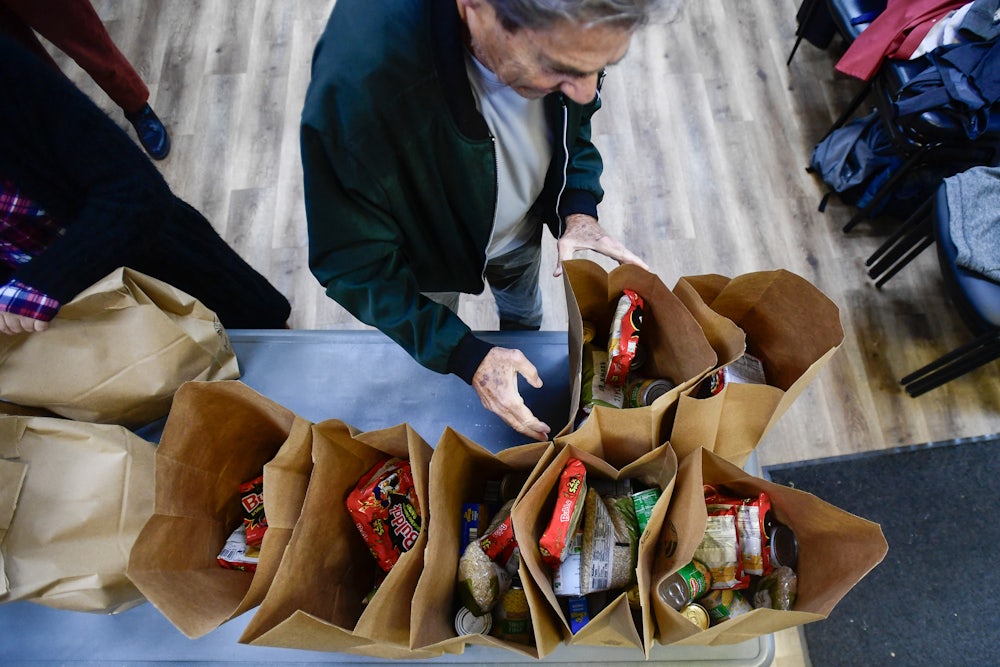For Nakia Lomax, it all started in July. She and her husband were working hard, picking up as many shifts as they could to cover rising food prices and higher costs of living, when they received notices that their children’s Medicaid and food stamps were ending because their income meant they no longer qualified. A few weeks later, they learned their son, who had just turned 16, had leukemia.
Since then, Lomax has felt torn in a dozen directions. She and her husband want and need to be there for their son while he is hospitalized and receives treatment, which means they can’t work as many hours. A social worker at the hospital helped them reapply for Medicaid, food stamps, and any other assistance that might be available, but the family still owes $10,000 for two weeks of medical care before the insurance kicked back in. At the same time, the cost of utilities has increased, while food prices are projected to soar even higher due to tariffs and deportations of food workers.
“The cost of living goes up. Our pay doesn’t,” Lomax told me. “My credit cards are maxed out from buying food. There’s been times where my husband and I, we’ve gone hungry just to make sure that our daughter and our son eat.”
The family only regained food stamps—known as SNAP, or the Supplemental Nutrition Assistance Program—in October. Almost immediately, Lomax worried they would disappear again, as Republicans in Congress began to hold SNAP funding hostage during negotiations about the U.S. government shutdown. Continuing to provide SNAP benefits would “reduce the pressure” on Democrats to capitulate, House Speaker Mike Johnson said on CNN on Thursday, which could make them stop opposing a plan that would result in skyrocketing health care premiums. Democrats tried to pass a bill last week to extend SNAP and WIC, the Special Supplemental Nutrition Program for Women, Infants, and Children, but Republicans blocked it. And Trump’s megabill over the summer put new restrictions on SNAP, which means 2.4 million people may lose their food stamps. The administration also slashed $1 billion in funding for food banks.
On Friday, a judge ordered the Trump administration to disburse about $5.25 billion in emergency funding—a little more than half of the $8 billion or so spent on SNAP each month. But the judge gave the administration until Monday to deliver a plan for payment, and the administration still hasn’t said whether it will comply with the ruling. On Saturday, the first of the month, assistance ended for millions.
More than 41 million people rely on SNAP, which is a federal program administered by states. Children make up more than a third (39 percent) of SNAP participants, as of 2023. Senior citizens account for almost one in five (19 percent). More than 20,000 military families and some 213,000 National Guard and Reserve members are on SNAP. An estimated 14,500 Walmart workers receive food stamps, according to the Government Accountability Office.
“Everything’s rising except for wages,” Tashara Leak, associate professor of nutritional sciences at Cornell University and a registered dietitian, told me. Housing costs are up, unemployment is increasing, “and the cost of food right now is unprecedented,” she said. People were already struggling, and now they’re racing to understand whether they will have enough food for their families.
November and December are particularly bad times for disruptions to food assistance. “The holidays also mean that children are going to be home way more,” Leak said. Children who would normally rely on free or reduced breakfast and lunch, and other food offered through school, may go hungry at home. “You’re going to have more mouths to feed but fewer resources.”
Yet even if the administration complies with the court order to distribute the emergency funds, that won’t be enough, and the shutdown could continue for weeks or months—all while food costs continue to rise. “We’re going to be in a crisis,” Leak said. “Poor people are, right now, collateral damage.” And with layoffs, especially from government jobs, more people are experiencing insecurity. “We are not fully understanding the multiple ways in which I think we’re going to see a whole ’nother brand of poverty,” Leak said. “There’s a whole new category of people who probably never experienced food insecurity before, who are experiencing it for the first time.”
De Doyle’s father is a veteran, a senior citizen who values his independence, the kind of guy who sneaks a jar of peanut butter to a neighbor when he suspects they don’t have enough. But he himself lives on a fixed income, relying on Social Security, food stamps, and—though she would never, ever tell him this—the occasional help from Doyle. She manages his finances completely, ordering him groceries every two weeks through delivery because she lives in Pennsylvania and he lives in Florida. Sometimes, when the bill is too high, she covers some of it.
He doesn’t get much through SNAP, and that amount just dropped in October, from $67 to $46 each month. Even so, every little bit helps, Doyle said. She feels lucky that she is able to step into the gap while food assistance is in turmoil. But she can’t do it for very long, and she’s also worried about her son, who is active-duty military, not getting paid during the government shutdown. Doyle’s health care premiums just went up, so even though she got a raise at work, she is bringing home less money now.
If food stamps aren’t restored soon, Doyle will have to convince her father to move up to Pennsylvania with her. Buying food in bulk would be cheaper. “I don’t know that he can continue to live on his own if we’re not going to have just that little bit of support,” Doyle said. “There’s just not enough money to get him to the end of the month.”
Myths and misinformation about SNAP beneficiaries abound. “A common misconception is that somebody on food stamps doesn’t manage their money. I manage my dad’s money. There’s very little,” she said. But the biggest misconception is that people on SNAP don’t work, she said. Many people receiving food assistance have jobs, and those who don’t work can’t, because they are disabled or caring for a disabled child, or they are elderly. “My father worked until he could no longer work,” Doyle said.
Seniors like her dad might hesitate to go to a food bank, even if they have transportation, because they don’t want to take food from young families, Doyle said. “People will absolutely forgo eating if they know the food that they would have eaten is going to a child.” Yet it’s growing cold as winter approaches, and everyone needs more calories when it’s cold, creating even more shortages and worries, she pointed out.
“It’s touching every part of our lives, and it is grueling, and it’s an everyday worry, right? This SNAP thing is an everyday worry,” she said. “It’s just stretching everybody like a rubber band. And when are we going to snap?”
Even if SNAP restarts, it has caused immeasurable stress and anxiety among recipients, their families, and their communities. The halt to assistance will ripple throughout the food system, affecting availability and prices for everyone—and the damage goes beyond food.
“What we’re not focusing enough on is that it’s not just about SNAP. This is all about the many ways in which people who are living in poverty are struggling,” Leak said. “This just seems like fuel on an already existing fire.” Workers, especially for the government, have been laid off. Much of the work available doesn’t pay a livable wage. At the same time, housing costs—rent, utilities, property taxes—have soared. Health insurance premiums, especially those offered through Affordable Care Act exchanges, are reaching absurd heights. Food, especially nutritious food, often comes last.
It’s gutting not to be able to provide these essentials for your family, Leak said, “but there’s actually something even bigger happening, which is a distrust of government. The government is not supportive of the health and well-being of Americans.”
Even when the shutdown ends, even if assistance is restored, the distrust will continue, Leak said. “What’s next? That’s what people are thinking. What’s the next thing that’s going to happen that’s going to impact my ability to care for my family? And that’s what I think is really scary. That’s what I think people are really terrified about.”
Lomax lives in Delaware, which is one of the states (and the District of Columbia) suing the Trump administration to release the emergency funds. In the meantime, Delaware declared a state of emergency and will offer food stamps on a weekly basis, starting on Friday. That’s a relief for Lomax, but she’s still struggling to plan.
“I’m sitting here right now trying to picture in my mind, every week, what we can eat, what we can afford, where I need to go,” she said. “I remember when a loaf of bread was 99 cents or lower. Now it’s $1.50, almost $2, and I’m just like, OK, maybe if I make homemade—but that’s still expensive, all the ingredients to make the homemade bread.” She would like to visit a food bank, but they’re usually open during the week, when she’s working, or occasionally on Saturdays, which are devoted to her son’s medical treatments.
Her son’s leukemia is in remission, but they are now starting an aggressive chemotherapy schedule for the next two months to keep the cancer away for good. The teenager will be hospitalized for four to five days every two weeks. “I have to tear myself in half,” Lomax said, because she needs to be there for her son and she also needs to make sure her daughter is OK at home. SNAP should be the last thing on her mind right now. “That’s what I constantly think about,” she said.
“It just feels like no one understands this class of people,” Lomax said. She’s been working since she was 16; she’s now an experienced massage therapist, and her husband works at a car dealership. “We’re in the middle. We have a home. We’re doing everything that we’re supposed to do: two-parent household, we both work. That’s supposed to be the American dream. I don’t see the pot of gold at the end of the rainbow.”
Yet Lomax repeats, several times, that she needs to stay positive. She holds onto it like a promise: She will get through this because she has no other choice. She will find a way to stretch what she has, even when she feels torn apart. “Especially right now, it’s hard to see the rainbow, but I’ve got to stay positive. You’ve got to believe that there’s a rainbow.”








